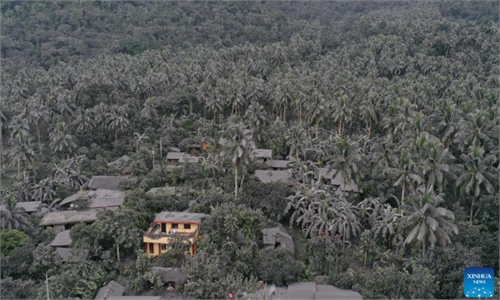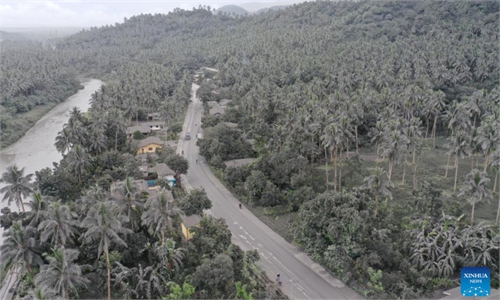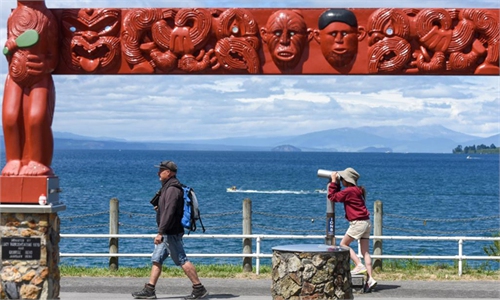Magma symphony could help experts predict volcanic eruptions
Inaudible sonic rumblings from deep in a volcano's bowels could provide a warning when it is about to blow, scientists said on Thursday, offering threatened communities the prospect of a life-saving heads-up.
A team studying "infrasounds" - sounds too deep for humans to hear - from volcanoes like Italy's Mount Etna has discovered that magmatic gurgles change markedly as an eruption nears.
As magma explodes, soundwaves reverberate through the crater "just like in some brass musical instrument, like a trombone, for example, you get certain notes," explained Leighton Watson, a University of Canterbury researcher who was part of a multi-national team.
As the magma moves upward, the note changes - like the moving of a trombone arm, he told AFP.
Before Etna belched smoke and ash high into the air in February 2021, its tune started to change.
"The peak frequency increased and increased and increased, and the reason for that was the magma was rising up in the crater."
By figuring out which notes equate to each magma level, predictions could be made about future eruptions.
Watson and the team of scientists based in Italy and the US believe the notes could eventually give "several hours" of warning before an impending eruption.
That would not be enough to protect houses or infrastructure, but it could be enough to get locals, tourists or skiers out of the way.
Current methods of monitoring magma levels involve flying a helicopter over the crater or climbing up and pointing a laser measuring device inside - both of which are dangerous, costly and cannot be done continuously.
The new method would require probes that can be placed kilometers away from the volcano.
Specialized microphones able to detect this ultra-low-pitched volcanic symphony were only developed a few decades ago, so the research is still in its infancy.
The group's findings, published this week in Nature's peer-reviewed journal Scientific Reports, showed there is still lots of work to do before predictions are reliable.
Unfortunately, the method does not work for all volcanoes.
For now, research is focused on open-vent volcanoes, which are "prodigious" sources of infrasound, according to the study.
Aside from Etna, Kilauea in Hawaii, Villarrica in Chile and Nyiragongo are all candidates for further study.
Watson said more work also needed to be done to determine what rates or patterns of magma rise led to eruptions, and which might cause a false alarm.
"We need more observation," he said. "We've done it on the interesting cases where there has been an eruption, but in order to develop a forecasting model you need less interesting cases where there is no eruption.
"How many times does this phenomenon happen? And how many times is it followed by an eruption versus not followed by an eruption? It's just a matter of looking at a lot more data."
A team studying "infrasounds" - sounds too deep for humans to hear - from volcanoes like Italy's Mount Etna has discovered that magmatic gurgles change markedly as an eruption nears.
As magma explodes, soundwaves reverberate through the crater "just like in some brass musical instrument, like a trombone, for example, you get certain notes," explained Leighton Watson, a University of Canterbury researcher who was part of a multi-national team.
As the magma moves upward, the note changes - like the moving of a trombone arm, he told AFP.
Before Etna belched smoke and ash high into the air in February 2021, its tune started to change.
"The peak frequency increased and increased and increased, and the reason for that was the magma was rising up in the crater."
By figuring out which notes equate to each magma level, predictions could be made about future eruptions.
Watson and the team of scientists based in Italy and the US believe the notes could eventually give "several hours" of warning before an impending eruption.
That would not be enough to protect houses or infrastructure, but it could be enough to get locals, tourists or skiers out of the way.
Current methods of monitoring magma levels involve flying a helicopter over the crater or climbing up and pointing a laser measuring device inside - both of which are dangerous, costly and cannot be done continuously.
The new method would require probes that can be placed kilometers away from the volcano.
Specialized microphones able to detect this ultra-low-pitched volcanic symphony were only developed a few decades ago, so the research is still in its infancy.
The group's findings, published this week in Nature's peer-reviewed journal Scientific Reports, showed there is still lots of work to do before predictions are reliable.
Unfortunately, the method does not work for all volcanoes.
For now, research is focused on open-vent volcanoes, which are "prodigious" sources of infrasound, according to the study.
Aside from Etna, Kilauea in Hawaii, Villarrica in Chile and Nyiragongo are all candidates for further study.
Watson said more work also needed to be done to determine what rates or patterns of magma rise led to eruptions, and which might cause a false alarm.
"We need more observation," he said. "We've done it on the interesting cases where there has been an eruption, but in order to develop a forecasting model you need less interesting cases where there is no eruption.
"How many times does this phenomenon happen? And how many times is it followed by an eruption versus not followed by an eruption? It's just a matter of looking at a lot more data."



